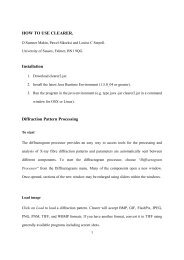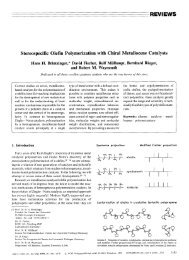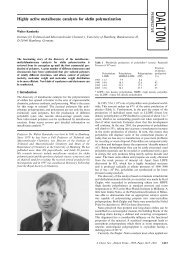Cocatalysts for Metal-Catalyzed Olefin Polymerization: Activators ...
Cocatalysts for Metal-Catalyzed Olefin Polymerization: Activators ...
Cocatalysts for Metal-Catalyzed Olefin Polymerization: Activators ...
You also want an ePaper? Increase the reach of your titles
YUMPU automatically turns print PDFs into web optimized ePapers that Google loves.
1408 Chemical Reviews, 2000, Vol. 100, No. 4 Chen and Marks<br />
complexes. For instance, the reaction of the sterically<br />
encumbered borane PBB with group 4 metallocene<br />
and CGC dialkyls having a variety of symmetries<br />
(C2v, C2, or Cs) af<strong>for</strong>ds cationic, µ-Me dinuclear<br />
complexes (e.g., 43; eq 30), 73,180 except <strong>for</strong> Cp′2ThMe2,<br />
CGCZrMe2, and Cp′MMe3 which <strong>for</strong>m the corresponding<br />
monomeric cationic complexes. 77 The remarkably<br />
enhanced stability of µ-Me bonding here<br />
likely reflects reduced coordinative tendencies of<br />
bulky MePBB - vs CH3B(C6F5)3 - and the neutral<br />
LL′MMe2 precursors, the latter of which exhibit a<br />
greater affinity <strong>for</strong> the LL′MMe + cation than does<br />
MePBB - . The solid-state structure of 43 features a<br />
discrete separated, dinuclear cation and a MePBB -<br />
anion (Figure 12). For those metallocene and related<br />
systems <strong>for</strong>ming diastereomers in the dimeric <strong>for</strong>m,<br />
the ratio of diastereomers <strong>for</strong>med depends on the<br />
ancillary ligation. For example, CGCTiMe2 remarkably<br />
yields only one of the two possible diastereomers<br />
on reaction with PBB, 143 while other complexes <strong>for</strong>m<br />
diastereomers in much closer ratios. 77<br />
The isolated and well-characterized cationic, bimetallic<br />
zirconium µ-Me complexes are effective initiators<br />
<strong>for</strong> polymerization of methyl methacrylate<br />
(MMA). 77 Depending on symmetry of the dimethylzirconocene<br />
precursor, either moderately syndiotactic<br />
P(MMA) (rr ∼ 65%) from C2v-symmetric precursors,<br />
or highly isotactic P(MMA) (mm ∼ 93%) from<br />
C2-symmetric precursors can be obtained. Interestingly,<br />
cationic dimers from Cs-symmetric precursors<br />
having CGC and Me2C(Flu)Cp ligations do not initiate<br />
MMA polymerization, presumably due to the<br />
openness of the coordination sphere of such Lewis<br />
acidic metal centers and thus stronger binding of the<br />
basic MMA monomer. Similar findings have been<br />
reported by Soga et al., 181 who reported that monomeric<br />
dimethylzirconocenes in combination with stoichimetric<br />
amounts of activators such FAB and<br />
Ph3C + B(C6F5)4 - , in the presence of a large excess of<br />
dialkylzinc, initiate syndiospecific (using bis-Cp type<br />
zirconocene) or highly isospecific (using rac-Et-<br />
(Ind)2ZrMe2 or rac-Me2Si(Ind)2ZrMe2) polymerization<br />
of MMA. However, no polymerization activity is<br />
observed with Me2C(Flu)CpZrMe2. 182 Collins et al. 183<br />
reported earlier that the cationic zirconocene complex<br />
Cp2ZrMe(THF) + BPh4 - promotes syndiospecific polymerization<br />
of MMA in the presence of excess<br />
neutral zirconocene dimethyl. The polymerization<br />
mechanism is different from that observed in olefin<br />
Figure 12. ORTEP drawing of the structure of the<br />
complex [(1,2-Me2Cp)2ZrMe]2(µ-Me) + (MePBB) - (43): (A)<br />
cation; (B) anion. From ref 77.<br />
polymerization. Slow initiation of this polymerization<br />
involves Me transfer from Cp2ZrMe2 toaCp2ZrMe + ‚<br />
MMA adduct to <strong>for</strong>m a neutral enolate, Cp2ZrMe(O-<br />
C-CH3dC(CH3)(CH2CH3), which then participates in<br />
the propagation process via intermolecular Michael<br />
addition to an activated monomer in the cationic<br />
adduct Cp2ZrMe + ‚MMA to ultimately produce PM-<br />
MA. 77,183<br />
Interestingly, the alkyl abstraction chemistry of<br />
tris(�-perfluoronaphthyl)borane (PNB) lies somewhere<br />
between B(C6F5)3 and PBB, af<strong>for</strong>ding either<br />
monomeric cationic complexes or dimeric cationic<br />
species, depending on the ratio of PNB to the metallocene<br />
or CGC precatalyst. 75 These activated species<br />
generally exhibit higher R-olefin polymerization<br />
activity than the FAB-derived analogues but lower<br />
acivity than the PBB-derived analogues, presumably<br />
reflecting the relative degree of cation-anion interaction<br />
and the anion-metallocenium cation coordinative<br />
tendency.<br />
Bifunctional bis(borane) 6 reacts with 1 or 2 equiv<br />
of Cp2ZrMe2 to produce a mixed borane/borate complex<br />
or bis(borate) complex (44), respectively. 78a The






